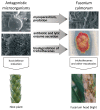Microbial Inhibition of Fusarium Pathogens and Biological Modification of Trichothecenes in Cereal Grains
- PMID: 29261142
- PMCID: PMC5744128
- DOI: 10.3390/toxins9120408
Microbial Inhibition of Fusarium Pathogens and Biological Modification of Trichothecenes in Cereal Grains
Abstract
Fungi of the genus Fusarium infect cereal crops during the growing season and cause head blight and other diseases. Their toxic secondary metabolites (mycotoxins) contaminate grains. Several dozen toxic compounds produced by fungal pathogens have been identified to date. Type B trichothecenes-deoxynivalenol, its acetyl derivatives and nivalenol (produced mainly by F. graminearum and F. culmorum)-are most commonly detected in cereal grains. "T-2 toxin" (produced by, among others, F. sporotrichioides) belongs to type-A trichothecenes which are more toxic than other trichothecenes. Antagonistic bacteria and fungi can affect pathogens of the genus Fusarium via different modes of action: direct (mycoparasitism or hyperparasitism), mixed-path (antibiotic secretion, production of lytic enzymes) and indirect (induction of host defense responses). Microbial modification of trichothecenes involves acetylation, deacetylation, oxidation, de-epoxidation, and epimerization, and it lowers the pathogenic potential of fungi of the genus Fusarium. Other modifing mechanisms described in the paper involve the physical adsorption of mycotoxins in bacterial cells and the conjugation of mycotoxins to glucose and other compounds in plant and fungal cells. The development of several patents supports the commercialization and wider application of microorganisms biodegrading mycotoxins in grains and, consequently, in feed additives.
Keywords: antagonistic bacteria; antagonistic fungi; biological control; biological modification of fusariotoxins; cereals.
Conflict of interest statement
The authors declare no conflict of interest.
Figures


References
-
- Pirgozliev S.R., Edwards S.G., Hare M.C., Jenkinson P. Effect of dose rate of azoxystrobin and metconazole on the development of Fusarium Head Blight and the accumulation of deoxynivalenol (DON) in wheat grain. Eur. J. Plant Pathol. 2002;108:469–478. doi: 10.1023/A:1016010812514. - DOI
-
- European Commission Commission Regulation (EC) No 1107/2009 of 21 October 2009. Concerning the Placing of Plant Protection Products on the Market. [(accessed on 2 December 2017)]; Available online: http://eur-lex.europa.eu/legal-content/EN/TXT/?uri=celex%3A32009R1107.
-
- European Commission Commission Regulation (EC) No 889/2008 of 5 September 2008 Laying down Detailed Rules for the Implementation of Council Regulation (EC) No 834/2007 on Organic Production and Labeling of Organic Products with Regard to Organic Production, Labeling and Control. [(accessed on 2 December 2017)]; Available online: http://eur-lex.europa.eu/legal-content/en/ALL/?uri=CELEX%3A32008R0889.
-
- Commission Regulation EC No 1881/2006 of 19 December 2006 Setting Maximum Levels for Certain Contaminants for Foodstuffs. [(accessed on 2 December 2017)]; Available online: http://eur-lex.europa.eu/legal-content/EN/TXT?url=CELEX:02006R1881-20170728.
Publication types
MeSH terms
Substances
LinkOut - more resources
Full Text Sources
Other Literature Sources
Medical

